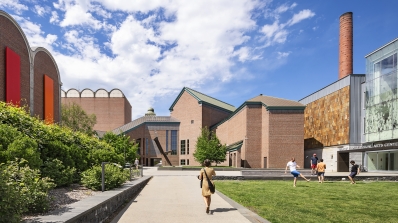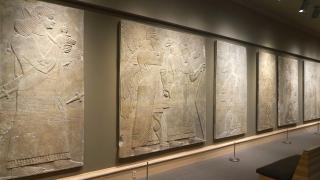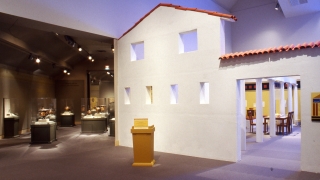Exhibitions Archive
The Hood Museum of Art's Assyrian Reliefs, 1856–2006
From Discovery to DartmouthThe Museum as Hunter and Gatherer
CollectaneaTo collect up to a final limit is not simply to own or to control the items one finds; it is to exercise control over existence itself through possessing every sample, every specimen, every instance of an unrepeatable and nowhere duplicated series.
—Roger Cardinal and John Elsner, The Cultures of Collecting
col·lec·ta·ne·a 1.) Passages, remarks, etc., collected from various sources; (as collect. sing.) a collection of passages, a miscellany. 2.) A selection of passages from one or more authors; an anthology.
This exhibition illuminates the broader social history of the Hood by exploring the diverse "authors" of its collection history and will look at how the museum's collection has been developed and (re)defined over time. Uniting traditional with contemporary and Western with non-Western art via pottery, sculpture, utilitarian objects, textiles, photographs, and prints, col·lec·ta·ne·a explores different collecting practices and ideologies that reflect the museum's unique identity as a hunter and gatherer of material culture. Topics addressed in the exhibition include the role of private collectors in developing museum collections; the continuation of older cultural traditions in newer forms; the relation between museum collections and teaching at Dartmouth; changing perspectives of "art" versus "artifact"; the value of "hybridized" art versus "authentic" art; and the continued development of the Hood's collections in new and interesting ways.
Teaching with the Hood's Collections
Critical FacultiesImages of Childhood from the Classical Past
Coming of Age in Ancient GreeceIt is not widely known that ancient Greek artists were the first to create images of children that showed them as they were instead of as miniature adults. They also observed and recorded children’s characteristic gestures, their bonding with parents and caregivers, their various activities from learning to crawl to assisting in religious ceremonies, and their love of play. In the absence of extensive written testimony about children from this period, artifacts and images are a vital link to the lives of girls and boys from birth to adolescence.
Coming of Age in Ancient Greece: Images of Childhood from the Classical Past is the first major exhibition to explore these images of childhood from ancient Greece. Over 120 art objects on loan from American, Canadian, and European collections chronicle the emotional and familial environment in which children were raised, their participation in religious rituals, the commemorative objects that marked their early death, and their transition to adulthood. The exhibition also presents images and stories of children in mythology. Painted vases, sculptures, grave monuments, and artifacts such as toys and baby feeders bring ancient Greek children’s experiences to life.
Pages
- « first
- ‹ previous
- 1
- 2
- 3


